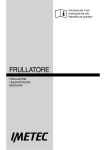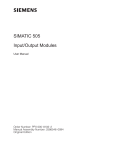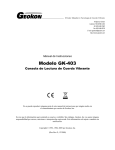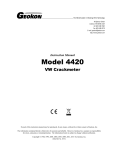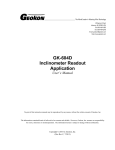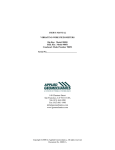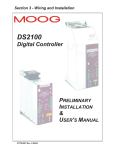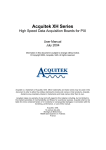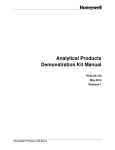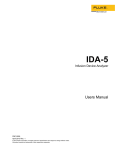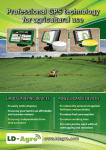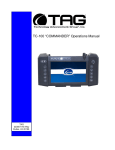Download Model GK-405 Vibrating Wire Readout
Transcript
Model GK-405 Vibrating Wire Readout User’s Manual No part of this instruction manual may be reproduced, by any means, without the written consent of Geokon, Inc. The information contained herein is believed to be accurate and reliable. However, Geokon, Inc. assumes no responsibility for errors, omissions or misinterpretation. The information herein is subject to change without notification. Copyright © 2013 - 2015 by Geokon, Inc. (Doc Rev D, 10/2015) Warranty Statement Geokon, Inc. warrants its products to be free of defects in materials and workmanship, under normal use and service for a period of 13 months from date of purchase. If the unit should malfunction, it must be returned to the factory for evaluation, freight prepaid. Upon examination by Geokon, if the unit is found to be defective, it will be repaired or replaced at no charge. However, the WARRANTY is VOID if the unit shows evidence of having been tampered with or shows evidence of being damaged as a result of excessive corrosion or current, heat, moisture or vibration, improper specification, misapplication, misuse or other operating conditions outside of Geokon's control. Components which wear or which are damaged by misuse are not warranted. This includes fuses and batteries. Geokon manufactures scientific instruments whose misuse is potentially dangerous. The instruments are intended to be installed and used only by qualified personnel. There are no warranties except as stated herein. There are no other warranties, expressed or implied, including but not limited to the implied warranties of merchantability and of fitness for a particular purpose. Geokon, Inc. is not responsible for any damages or losses caused to other equipment, whether direct, indirect, incidental, special or consequential which the purchaser may experience as a result of the installation or use of the product. The buyer's sole remedy for any breach of this agreement by Geokon, Inc. or any breach of any warranty by Geokon, Inc. shall not exceed the purchase price paid by the purchaser to Geokon, Inc. for the unit or units, or equipment directly affected by such breach. Under no circumstances will Geokon reimburse the claimant for loss incurred in removing and/or reinstalling equipment. Every precaution for accuracy has been taken in the preparation of manuals and/or software, however, Geokon, Inc. neither assumes responsibility for any omissions or errors that may appear nor assumes liability for any damages or losses that result from the use of the products in accordance with the information contained in the manual or software. 3 Table of Contents: List of Tables: ................................................................................................ 9 1. Introduction .............................................................................................. 1 1.1 Features ...........................................................................................2 1.2 GK-405 Vibrating Wire Readout Application ...........................................3 1.3 Before using the GK-405 Vibrating Wire Readout ..................................4 2. Installation and Operation......................................................................... 5 2.1 Initial Quick Start Sequence ................................................................5 2.2 Establishing contact with the Remote Module .......................................7 2.3 Installing the GK-405 VWRA ............................................................. 10 2.3.1 Launching the GK-405 Installer ........................................................................... 11 2.4 Starting the Vibrating Wire Readout the first time ............................... 16 3. User Interface ..........................................................................................19 3.1 Overview ........................................................................................ 19 3.2 Live Readings Screen – Raw Readings ................................................ 19 3.2.1 Display Mode ............................................................................................................... 20 3.2.2 Sensor Index ............................................................................................................... 21 3.3 Sensor Selection Screen ................................................................... 24 3.3.1 Project Explorer.......................................................................................................... 25 3.4 Application Menu ............................................................................. 29 3.4.1 Live Readings .............................................................................................................. 30 3.4.2 Edit Settings ................................................................................................................ 37 3.4.3 Remote Connect with… ........................................................................................... 37 3.4.4 Terminal Window ....................................................................................................... 38 3.5 File Menu ........................................................................................ 39 5 3.5.1 Delete Data Files ........................................................................................................ 40 3.5.2 Export Menu ................................................................................................................. 41 3.5.3 Import Menu ................................................................................................................ 46 3.5.4 View Data ...................................................................................................................... 47 3.5.5 Close GK-405 ............................................................................................................... 48 4. Configuring Project Explorer Elements ..................................................... 49 4.1 Project Configuration ....................................................................... 49 4.2 Sensor Configuration ....................................................................... 50 5. Files, Folders and Transferring Data ......................................................... 57 5.1 File Transfer ................................................................................... 57 5.2 Backing up configurations ................................................................ 58 APPENDIX A. GK-405 Connections ............................................................... 59 A.1. Single Sensor Connection ................................................................ 59 A.2. Load Cell Connection ...................................................................... 60 A.3. Charger Connections ...................................................................... 61 APPENDIX B. Remote Module Command Structure...................................... 62 APPENDIX C. Data File Formats .................................................................... 64 C.1 Raw Data Text Report ...................................................................... 64 C.2 Data Text Report with Column and Report Headers ............................. 65 APPENDIX D. Specifications ......................................................................... 66 D.1 GK-405 (Remote Module) Specifications ............................................ 66 D.2 Hand-Held Device (HHD-NX7-B) Specifications ................................... 67 Table of Figures: Figure 1 - GK-405 with handheld PC in cradle ........................................................................................1 Figure 2- Vibrating Wire Gage and Load Cell Connectors .......................................................................2 Figure 3 - Hand-held PC running GK-405 VWRA .....................................................................................3 Figure 4- ActiveSync Window showing active connection .................................................................. 10 Figure 5 - Windows Mobile Device Center .......................................................................................... 11 Figure 6 - Windows Explorer window displaying HHD root folder ...................................................... 12 Figure 7 - Hand-held device root folder contents................................................................................ 12 Figure 8 – Installation Folder Contents ................................................................................................ 13 Figure 9 - GK-405 Installer at root of HDD ........................................................................................... 14 Figure 10 - GK-405 Install Screen ......................................................................................................... 14 Figure 11 - GK-405 VWRA Icon in Start->Programs ............................................................................. 15 Figure 12- Select Workspace Name ..................................................................................................... 16 Figure 13 - Workspace Folder Selection .............................................................................................. 17 Figure 14 - Workspace Exist ................................................................................................................. 17 Figure 15 - Remote module not found Figure 16 - Default initial screen ......................................... 18 Figure 17 - Live Readings – Raw Readings ........................................................................................... 19 Figure 18 - Display Mode drop-down menu......................................................................................... 20 Figure 19 - Sensor Index drop-down control ....................................................................................... 21 Figure 20 - Menu Options .................................................................................................................... 22 Figure 21 - View Options ...................................................................................................................... 22 Figure 22 - Landscape Mode ................................................................................................................ 23 Figure 23 - Portrait Mode Menu Option .............................................................................................. 23 Figure 24 - Sensor Selection Screen ..................................................................................................... 24 Figure 25 - Project Explorer with expanded projects .......................................................................... 25 7 Figure 26 - Context Menu ..................................................................................................................... 26 Figure 27 - Workspace Selection Window Figure 28 - List of Workspace Names ............................. 27 Figure 29 - Sort Elements Sub-Items .................................................................................................... 28 Figure 30 - Application Menu ............................................................................................................... 29 Figure 31 - Sensor Selection Screen, Remote Module Connected ....................................................... 30 Figure 32 - Live Readings Menu Selections .......................................................................................... 31 Figure 33 - Live Readings Screen (Sensor Selected) ............................................................................. 31 Figure 34 - Menu Options ..................................................................................................................... 32 Figure 35 - Clear Data Warning ............................................................................................................ 33 Figure 36 - Storage Configuration Dialog ............................................................................................. 34 Figure 37 - View Options ...................................................................................................................... 35 Figure 38 - Displayed Sensor Readings ................................................................................................. 36 Figure 39 - Live Readings - With Selected Sensor (Landscape Mode) .................................................. 36 Figure 40 - Remote Connect with... ...................................................................................................... 37 Figure 41 - Terminal Window ............................................................................................................... 38 Figure 42 - File Menu Options .............................................................................................................. 39 Figure 43 - Delete Data Files Window .................................................................................................. 40 Figure 44 - Export Menu ....................................................................................................................... 41 Figure 45 - Export Data Window Figure 46 - Save File Window ....................................................... 42 Figure 47 - Extended Format Window.................................................................................................. 42 Figure 48 - Select Sensor(s) to Export Figure 49 - Select Export Folder and Mode........................... 44 Figure 50 - Export Path Selection Window Figure 51 - No Project Selected Error ............................ 45 Figure 52 - Select Project Export File .................................................................................................... 46 Figure 53 – Data File Selection Window ............................................................................................... 47 Figure 54 - Sensor Reads Window ........................................................................................................ 47 Figure 55 - Project Settings ................................................................................................................... 49 Figure 56 - Sensor Settings Window (page 1) ...................................................................................... 50 Figure 57 - Sensor Settings (49xx selected) ......................................................................................... 51 Figure 58 – Sensor Settings, Linear Coefficients (page 2) .................................................................... 52 Figure 59 - Sensor Settings, Polynomial Coefficients (page 2)............................................................. 53 Figure 60 - Sensor Settings (page 3) .................................................................................................... 54 Figure 61 - Sensor Settings (page 4) .................................................................................................... 55 Figure 62 - Single Sensor Connector .................................................................................................... 59 Figure 63 - Load Cell Connector ........................................................................................................... 60 Figure 64 - Charger Connection ........................................................................................................... 61 Figure 65 - Enhanced Data Text Report ............................................................................................... 65 List of Tables: Table 1 - Display Mode options (A-F) ................................................................................................... 20 Table 2 - Folder paths and File Names ................................................................................................. 57 Table 3 - Single Sensor Pin-out ............................................................................................................ 60 Table 4 - Load Cell Connector Pin-out ................................................................................................. 61 Table 5 - Remote Module Command Format ...................................................................................... 62 9 1 1. Introduction The GK-405 Vibrating Wire Readout is made up of two components: the Readout Unit, consisting of a Windows Mobile handheld PC running the GK-405 Vibrating Wire Readout Application (see Figure 3) the GK-405 Remote Module which is housed in a weather-proof enclosure and connects to the vibrating wire gage to be measured. Figure 1 - GK-405 with handheld PC in cradle The two components communicate wirelessly using Bluetooth ®, a reliable digital communications protocol. The Readout Unit can operate from the cradle of the Remote Module (see Figure 1) or, if more convenient, can be removed and operated up to 20 meters from the Remote Module (see Note 1). Note 1: In most cases 20 meters will be the maximum but differences in battery, atmospheric and geographic conditions may reduce the actual effective range. 1 2 1.1 Features Rugged, general purpose, reliable readout based on a Windows Mobile handheld PC: all the benefits of a Windows compatible device (Windows file system, RS-232, USB and wireless connectivity) long battery life ease of use Lightweight and simple Remote Module: lithium battery (8+ hours of continuous use) one button operation; automatic power down when Bluetooth connection is dropped or after several minutes of inactivity reliable connection to standard vibrating wire gages and load cells is accomplished via two 10-pin Bendix connectors (see Figure 2) housed in a durable aluminum enclosure Figure 2- Vibrating Wire Gage and Load Cell Connectors 3 1.2 GK-405 Vibrating Wire Readout Application The GK-405 Vibrating Wire Readout Application (GK-405 VWRA) installs and runs on a ruggedized hand-held PC (see Figure 3) and is designed to communicate via Bluetooth with Remote Modules connected to vibrating wire gages. Figure 3 - Hand-held PC running GK-405 VWRA 3 4 1.3 Before using the GK-405 Vibrating Wire Readout The readout software runs as an application under Windows Mobile 5 or 6 operating system installed on a hand-held PC. Please familiarize yourself with the hand-held PC and the Windows Mobile OS. It is assumed in the instructions below that you can launch applications from the Start button including File Explorer and the Bluetooth Settings manager. It is assumed that you can tap the keyboard icon as needed and use the onscreen keyboard to enter text and numbers. 5 2. Installation and Operation The steps described in section 2.1 are an attempt to guide the user through the process of launching the GK-405 VWRA, connecting to the sensor and taking a reading. If all parts of the GK-405 are purchased as a system, Geokon makes every effort to ensure that the system is completely set up and working before it leaves the factory. Other times, the user may already own the hand-held PC and are setting up their hardware and software for the very first time. The steps below attempt to cover all cases and refer the user to the appropriate section when more information is needed. For those users that have purchased a complete GK-405 system, a workspace with the name of “GK405” will have been pre-defined and the hand-held unit will already be paired with the Remote Module. Note that the workspace name can be changed at any time or new ones can be created (see section 3.2.1). When purchasing a GK-405 system, sections 2.2 through 2.4 can possibly be skipped but a quick review is recommended. 2.1 Initial Quick Start Sequence The following steps are a guide to the typical operation of the GK-405 and, if followed, should result in a successful sensor measurement: A) If the Remote Module has been previously paired with the hand-held unit, then press the button labeled “POWER ON (BLUETOOTH)”. A blue light should turn on and begin blinking, signifying that the Remote Module is waiting to connect to the hand-held unit. If the Remote Module was purchased separately from the hand-held unit, see section 2.2 (Establishing Contact with the Remote Module). Launch the GK-405 VWRA by tapping on “Start” from the hand-held PC’s main window, then tap “Programs” then tap the GK-405 VWRA icon. If the GK-405 Vibrating Wire Readout Application has not been installed, please see section 2.3 (Installing the GK-405 VWRA). B) After a few seconds, the blue light on the Remote Module should change to a steady state blue (lit but not flashing) and the Live Readings Window will be displayed (see section 3.2, “Live Readings Screen - Raw Readings” - Figure 17). If the window shown in Figure 12 is displayed instead of the Live Readings Window, please refer to section 2.4, “Starting the Vibrating Wire Readout the first time”. 5 6 If the Live Readings Window is displayed but no Thermistor or Vibrating Wire output is shown, please refer to section Appendix A, “GK-405 Connections”. C) From the Live Readings Window (see Figure 17), different display modes may be selected as appropriate for the sensor (see section 3.2.1, “Display Mode”). If a sensor is connected that contains more than one vibrating wire “cell”, the “Sensor Index” may be changed to view the vibrating wire output for each “cell”, or the average may be displayed. D) If displaying sensor output in engineering units is desired, tap on “View” then “Sensor Selection Screen” to select a pre-defined sensor or to create a new sensor configuration. Please refer to section 3.3, “Sensor Selection Screen” as well as, section 4.2, “Sensor Configuration”. E) To close the GK-405 VWRA from the Live Readings Screen, tap “Menu” then “Close GK-405”. 7 2.2 Establishing contact with the Remote Module In general this should only need to be done once and is typically done before it leaves the factory. Follow the steps below to ensure the ‘partnership’ with the remote is established before using the readout software: 1. Use the Bluetooth Settings Manager on the hand-held PC to set up the link to the remote. Read about setting up a Bluetooth “partnership” in Chapter 9 of the hand-held PC’s Reference Guide. Two ways to start the Bluetooth Manager. 2. Once in the Bluetooth Settings Manager, click on the “Mode” tab and then make sure that the box next to “Turn on Bluetooth” is checked. 3. Click on the “Devices” tab. If it shows a “Geokon” device (name will start with “GK405” and contain the remote’s serial number), go to step 6. Otherwise turn on the remote module (should see a flashing blue indicator on the remote) and select “Add new device…”. 7 8 4. When a suitable remote is discovered, highlight the device and tap “Next”. 5. A prompt will be displayed for a password; enter “default” and tap “Next” again. If a partnership with the device is successfully established, the screen will momentarily display the prompt to the right and then return to the Bluetooth Devices screen. 6. Click on the COM Ports tab. If the “Geokon” device is already assigned to a COM Port, skip to step 9. If no COM Port is assigned, tap on “New Outgoing Port”. 9 7. The screen to the right is displayed. Select the appropriate device from the list and tap “Next”. 8. From the “Port:” drop-down list, select a COM port (COM5 is the default). Be sure to remember the number of the COM port as you may have to select it later in the readout software (see section 3.4.3). Make sure to “uncheck” the “Secure Connection” check-box. Tap “Finish” when done to return to the Bluetooth Settings “COM Ports” screen. 9. Lastly verify that the Bluetooth device is set for Serial Port operation. From the “Devices” tab of the Bluetooth Settings manager, tap the device to be used to communicate with the remote. The screen to the right will be displayed. Ensure that the “Serial Port” checkbox is checked. Tap “Save” to complete the Bluetooth Settings. 9 10 2.3 Installing the GK-405 VWRA The installation of the GK-405 VWRA requires the following: Hand-held device (HHD) running Windows Mobile Classic 5.X (6.X recommended) or higher with at least 50 Mbytes of free memory. HHD must be Bluetooth enabled and be able to assign a Bluetooth connection to a COM port. Windows .NET 3.5 Compact Framework (CF) and .NET framework Englishlanguage Messages package installed on HHD. Both “CAB” file installers are included in the GK-405 VWRA installer “Zip” file, available on Geokon’s web-site. Microsoft ActiveSync version 4.5.0 or higher installed on the host PC if host PC operating on Windows XP (see Figure 4). If host PC’s operating system is Vista, Windows 7 or Windows 8 (see Figure 5) then Windows Mobile Device Center should be installed on the host PC. An active connection between the host PC and the HHD must be established either via a physical link or Bluetooth. Figure 4- ActiveSync Window showing active connection 11 Figure 5 - Windows Mobile Device Center 2.3.1 Launching the GK-405 Installer From the Windows Mobile Device Center window on the PC (see Figure 5) click on the folder icon labeled “Browse the contents of your device” to call up an Explorer Window for the HHD (see Figure 6). The procedure for ActiveSync is very similar. 11 12 Figure 6 - Windows Explorer window displaying HHD root folder In the Figure 6 above, double-click the icon labeled “\” to navigate to the handheld PC’s system root shown in Figure 7. Figure 7 - Hand-held device root folder contents 13 Next, unzip the installer (downloaded from Geokon’s web-site), open a new Windows Explorer window and then navigate to the root folder of the installation folder (see Figure 8). Figure 8 – Installation Folder Contents Copy the file, “GK405_Installer.CAB” from the installer folder to the HHD system root folder. From the HDD, navigate to the system root folder using File Explorer (see Figure 9) and tap the file, “GK405_Installer” to execute the installer. 13 14 Figure 9 - GK-405 Installer at root of HDD If there is a storage card installed in the HHD then the user will be prompted to choose the location for the installation (see Figure 10). It is recommended that “Device” be selected then tap “Install” with the stylus to initiate the install process. Figure 10 - GK-405 Install Screen 15 The file, GK405_Installer.CAB can be now deleted from the system root folder to free up memory. The GK-405 VW Readout application is now installed and its icon should appear in “Start->Programs” (see Figure 11). Figure 11 - GK-405 VWRA Icon in Start->Programs 15 16 2.4 Starting the Vibrating Wire Readout the first time The readout software is launched by tapping the Start button and selecting the icon (to the right) from the drop down list or clicking on Programs and then clicking the icon (to the right). When starting the GK-405 Vibrating Wire Readout Application (GK-405 VWRA) for the first time, you will be prompted to create a workspace name. The workspace name can be any combination of letters and numbers and should be descriptive in nature. After creation, this name will be displayed in the Project Explorer window. Figure 12- Select Workspace Name Once you've selected the name for your workspace, you will be prompted to choose or create a folder on your hand-held device where all the workspace elements will be stored. As can be seen below, the default workspace location is in a folder name the same as the workspace name under a special shared folder reserved for workspaces. For Windows Mobile devices this folder is located at: \Application Data\Geokon\GK-405\Workspaces. GK-405 VWRA appends the name of the new workspace to this shared folder (see Section 5) and uses it as the default location for the new workspace. The user is free to select their own location, either by entering it directly, or the Browse [ … ] button may be used to navigate to a different folder location or to create a new folder (see below). This workspace location will be stored in the GK-405 VWRA configuration for subsequent application access. After workspaces are created, all future user access to workspaces is always by name. 17 Figure 13 - Workspace Folder Selection Note: If the newly selected workspace folder contains an existing workspace, GK-405 VWRA will display a dialog asking the user if they want to import the workspace as is or to rename it with the previously specified new workspace Figure 14 - Workspace Exist 17 18 After the initial workspace is created the GK-405 VWRA will attempt to connect to a remote module. If no remote module can be found then the error message seen in Figure 15 will be displayed. By default the GK-405 VWRA looks for a remote module connection on COM5 but will remember the COM number of the last successful connection. Please see section 2.2 for more information regarding establishing a connection with the remote module. If the connection attempt is unsuccessful, the newly created workspace will be opened by default and you will be able to create new project(s) and add new sensor configurations to your workspace (See Figure 16). Figure 15 - Remote module not found Figure 16 - Default initial screen Note: With all subsequent attempts to connect to the Remote Module, please ensure that the “Power On” button on the Remote Module has been pressed (blue light will be blinking) before launching the GK-405 VWRA. 19 3. User Interface 3.1 Overview Following a successful Bluetooth connection, the GK-405 VWRA will boot up displaying the screen shown in Figure 17. This is the Live Readings screen and it is shown in “Raw Readings” mode, meaning that output will be displayed in “raw” form (usually digits) since no sensor has been selected to supply parameters for engineering unit display. The following sections describe the GK-405 VWRA user interface in greater detail. 3.2 Live Readings Screen – Raw Readings Figure 17 shows a typical vibrating-wire piezometer output in digits and thermistor output in degrees Celsius. Figure 17 - Live Readings – Raw Readings In “Raw Readings” mode, the two on-screen controls that control gage measurement are “Display Mode” and “Sensor Index”. 19 20 3.2.1 Display Mode Display Mode selects pre-programmed parameters which are optimized for different gages. Each option has different scaling and processing characteristics. Figure 18 depicts the options available from the Display Mode drop-down menu. See Table 1 to determine the best choice for the sensor to be measured. Figure 18 - Display Mode drop-down menu Display Mode A Geokon Model Nos. all Calculation Period, T F2 x 10-3 Units microseconds Sweep Freq.(hz) 450-6000 digits 1400-3500 B 4300BX,4400, 4500,4600, 4700,4800,4900 C 4000 F2x10-3x4.062 microstrain 450-1200 D 4200 F2x10-3x3.304 microstrain 450-1200 E 4100 F2x10-3x0.39102 microstrain 1400-3500 F 4300EX F2 x 10-3 digits 2500-6000 (1) Table 1 - Display Mode options (A-F) Note 1: F = 1 / T 21 3.2.2 Sensor Index Some Geokon instruments are comprised of more than one sensor. For instance, a Geokon load cell may contain 3, 4 or 6 individual vibrating wire sensors per load cell. The Sensor Index control allows reading the individual sensors in an instrument as well as an average of all sensors (see Figure 19). Figure 19 - Sensor Index drop-down control In addition to the controls described in sections 3.2.1 and 3.2.2, Menu Options (see Figure 20) and View Options (see Figure 21) allow functionality such as storing, saving and viewing data. In “Raw Readings” mode, the only Menu Option enabled is “Close GK-405” while valid View Option choices are “Sensor Selection Screen”, described further in the next section (see section 3.3) and “Landscape Mode”. “Landscape Mode” and its converse, “Portrait Mode”, allow the orientation of the screen to be changed for optimal view-ability. Figure 22 shows the “Raw Readings” screen in “Landscape Mode”. Figure 23 shows the “Portrait Mode” menu option. 21 22 Figure 20 - Menu Options Figure 21 - View Options 23 Figure 22 - Landscape Mode Figure 23 - Portrait Mode Menu Option 23 24 3.3 Sensor Selection Screen The Sensor Selection Screen (see Figure 24) contains a number of navigation controls designed to make job of selecting application elements and functions easier. These navigation controls present an organizational view of the active workspace, inform the user about the state of the application, and provide the user with tools to configure and control Geokon devices. Figure 24 - Sensor Selection Screen The Sensor Selection Screen is comprised of several core components: Project Explorer Element selection tool. Context (drop-down) menu. Application Menu Allows display changes, workspace, project and sensor configuration as well as connection to the remote module. File Menu File and project explorer element exporting and importing. Data file viewing and deleting options. Status Area Displays the connection status of the application. Note: While the operator is using the functions and features of the Sensor Selection Screen, the Remote Module may timeout and drop the Bluetooth connection after about 6 minutes to conserve battery power. This is normal and the connection can easily be restored using “Remote Connect with…” Application menu option (see section 3.4.3 for more information). 25 3.3.1 Project Explorer The Project Explorer is the primary navigation mechanism for moving around the GK-405 VWRA workspace. The Project Explorer presents a view of the workspace which includes projects and sensors. These views reflect the hierarchical relationship between these elements. The highest element in the workspace hierarchy tree is a project. Projects allow a GK-405 VWRA user to group sensors into organizational units based on the user's preference. A project can reflect a specific site where sensors have been installed such as a construction project. This organizational feature makes it easy to find sensor configurations along with related data files. The list of sensors defined under the project can be viewed by selecting a specific project and expanding its branch in the explorer view (click on + sign preceding project name) (see Figure 25). In the hierarchy of the project explorer, sensors are child elements of a project. Sensor settings can be edited by selecting the desired sensor in the explorer tree. Once selected, sensor settings can be displayed using “Edit Settings” from the context menu (Figure 26) or by using the Application Menu (Figure 30). Figure 25 - Project Explorer with expanded projects 25 26 3.3.1.1 Context Menu From the Project Explorer, new workspace elements can be added by using the context menu. Access the drop-down menu by tapping and holding the explorer element that is to be operated on. A menu is then displayed that is context sensitive in that, based on the current selection, the appropriate elements will be enabled and others will be disabled. The screen-shot below shows the drop-down menu with the menu item, “Add Sensor”, enabled (not grayed out) since a “project” element is selected in the Project Explorer (Figure 26). Additional information for each context menu item follows: Figure 26 - Context Menu Switch Workspace: Use this context menu item to open any previously opened workspace, select a workspace from the file system or create a completely new workspace. Click this menu item to display the Workspace Selection window (see Figure 27). 27 Figure 27 - Workspace Selection Window Figure 28 - List of Workspace Names Click on the drop-down control to display the available workspaces (see Figure 28) Alternatively, a new name can be entered in the workspace name selection box. If the GK-405 VWRA recognizes the name as a workspace it has opened before, it will simply re-open the existing workspace. If the workspace name is new to the GK-405 VWRA then a workspace folder selection window is displayed (see Figure 13). Select the appropriate folder (or use the default) and a new workspace is created with the name entered above. Add Project: This menu item allows new projects to be created and added to a workspace. After tapping on this Context Menu item, the Project Settings Dialog will be displayed and can be edited. See section 4.1 for more information regarding project configuration. This menu item will only be enabled when the workspace is selected. 27 28 Add Sensor: This menu item allows new sensor configurations to be created and added to a project. After tapping on this Context Menu item, the Sensor Settings Dialog will be displayed and can be edited. See section 4.2 for more information regarding sensor configuration. This menu item will only be enabled when a project is selected. Delete Element: Project Explorer Elements can be deleted using this Context Menu item. A confirmation dialog will be displayed before the element is deleted. Edit Settings: This menu item allows configuration editing of the selected Project Explorer Element. See Section 3.4.2 for more information regarding configuration editing. Sort Elements: Project and Sensor explorer elements can be sorted by newest or oldest first by selecting the appropriate “Sort Elements” sub-item (see Figure 29). Figure 29 - Sort Elements Sub-Items 29 3.4 Application Menu The GK-405 VWRA Application Menu provides access to the high level application functionality. It is located in the lower, right corner of the main window frame (see Figure 30). The “Edit Settings” menu item can also be accessed via the context menu. Figure 30 - Application Menu 29 30 3.4.1 Live Readings This menu item will only be enabled if a successful connection has been established with the remote module. A successful connection is indicated by the icon to the right of the “Geokon” label as well as, a status of “Connected” at the bottom of the main screen. Both of the connection indicators are shown inside red ovals in Figure 31 (see section 2.2 and 3.4.3 for information regarding connecting to the remote module). Figure 31 - Sensor Selection Screen, Remote Module Connected Tapping on the “Live Readings” menu item displays the sub-menu shown in Figure 32). 31 Figure 32 - Live Readings Menu Selections 3.4.1.1 Live Readings - With Selected Sensor Tapping this menu item will cause the Live Readings screen to be displayed with its parameters initialized for the specific sensor selected (see Figure 33). Please refer to Appendix A for information regarding sensor connections. Figure 33 - Live Readings Screen (Sensor Selected) 31 32 Much like in “Live Readings – Raw Readings”, Display Mode contains selections “A – F”, corresponding to different sensor “pluck” frequencies (see Table 1). The “Live Readings - With Selected Sensor” window also contains a “G” selection for Display mode (the default when entering this window) which cause the raw sensor output to be converted to engineering units (see section 4.2, “Sensor Configuration”, for more information on engineering units). Note that when a sensor is selected, Live Readings contains a “Store” button that allows multiple readings to be stored for a particular sensor. With each tap on this button a new reading is stored for the selected sensor. Each time a reading is stored, a “beep” will be heard from the hand-held unit. A different sensor can be selected for measurement by accessing the dropdown box to the right of the “Sensor Name:” label. The new sensor can be chosen from the list of all sensors in the project. Figure 34 - Menu Options 3.4.1.1.1 Menu Options The available Menu options (see figure 34) are outlined below: Clear Data – Allows clearing of all readings stored (in the current session) for the selected sensor. Tapping this menu option displays the warning shown in Figure 35. Tapping “Yes” will clear all data (from the current session) and will reset the “Readings Stored:” counter to “0”. This feature has no effect on previously saved data. 33 Figure 35 - Clear Data Warning Save Stored Data – Saves all stored data (from the current session) for the selected sensor. A message is displayed informing the user how many readings were stored. The “Readings Stored:” counter will also be reset to “0”. The readings are saved to a file contained in a special data folder under the sensor configuration folder structure. The readings are either saved to a new data file or appended to an existing data file. Please refer to the “Storage Configuration” section below for more information. Store Zero Reading Value – This feature allows the currently displayed reading to be used and the sensor configuration’s “Zero Reading” value. When this menu item is tapped, a snapshot of the current reading is taken and converted to digits. Before storing this raw value in the sensor configuration, a confirmation dialog is displayed giving the user the opportunity to see the value before continuing. Storage Configuration – Under the grouping of “Auto Store Settings” are two parameters that allow multiple readings to be taken over time. Select “Auto Store: Enable” (see Figure 36) as well as an interval in seconds to enable readings to be stored periodically without intervention from the user. At any time this feature can be turned off by selecting “Auto Store: Disable” and 33 34 tapping “Save”. Under the grouping of “Data Saving Settings” is a parameter that determines whether data is appending to a previous data file or if a new file is created each time stored data is saved. As shown in Figure 36, the last saved data file is displayed when the “Append to Previous File” is selected. The “Last saved data file” has no meaning if “When saving data:” is set to “Create New File” and is not shown. Figure 36 - Storage Configuration Dialog Close GK-405 – Shuts down the application and breaks the connection to the Remote Module. The user will be given the opportunity to save any stored data (from the current session). 35 Figure 37 - View Options 3.4.1.1.2 View Options The available View options (see Figure 37) are outlined below: All Reads for this Sensor – This feature displays a window showing all stored reads for the selected sensor in the current session (see Figure 38). The display is an abbreviated version of one used in section 3.5.3, “View Data”, with just the date and time, sensor read (in engineering units) and temperature. Sensor Selection Screen – This option returns operation to the “Sensor Selection Screen” where other sensors may be selected, edited or created. See section 3.3 for more information. Landscape Mode – This “View” option and its converse, “Portrait Mode”, allow the orientation of the screen to be changed for optimal view-ability. Figure 39 shows the “Live Readings – With Selected Sensor” screen in “Landscape Mode”. 35 36 Figure 38 - Displayed Sensor Readings Figure 39 - Live Readings - With Selected Sensor (Landscape Mode) 3.4.1.2 Live Readings – Raw Readings See section 3.2 of this manual. 37 3.4.2 Edit Settings As with the Context Menu (see section 3.2.1), tapping the “Edit Settings” menu will invoke the Settings Editor for the currently selected Project Explorer element (See the section 4, “Configurations” for more information on settings). 3.4.3 Remote Connect with… If the application displays the status, “Connection Failed” as shown in Figures 15 and 16 at any time, the following options should be considered: Make sure the remote is turned on (blue light blinking). Select the “Application” menu option “Remote Connect with” (see Figure 30) and pick the COM port previously established in section 2.2 (see Figure 40). Figure 40 - Remote Connect with... A successful connection is reflected in the Main Screen status as in Figure 31. 37 38 3.4.4 Terminal Window This feature requires an active Bluetooth connection to the Remote Module. If enabled, tapping this menu option calls up the screen shown in Figure 41. Using the “Terminal Window” requires the use of the on-screen keyboard to enter simple one or two character commands to the Remote Module. See Appendix B for more information regarding the Remote Module command structure. Figure 41 - Terminal Window After typing a command in the “Command:” text box, tap the “Send” menu to issue the command to the Remote Module. Repeated taps of “Send” will reissue the same command. Typing a command in the “Command:” text box, followed by a keyboard “Enter” will cause the Remote Module to execute the command one time only. 39 3.5 File Menu The file menu is used to import and export Project Explorer element settings along with data export, viewing and report generation. It also is used to delete previously saved sensor data files (see Figure 42). Figure 42 - File Menu Options 39 40 3.5.1 Delete Data Files If a sensor is selected and contains data files then tapping on the “Delete Data Files” File Menu option displays the window shown in Figure 43. Figure 43 - Delete Data Files Window Select one or more individual files or use the “Select All Files” checkbox to select all files. Tapping on “Select” will cause the GK-405 VWRA to prompt the user to confirm that they really want to delete the selected files. Tap on “Yes” to finish the deletion. 41 3.5.2 Export Menu The Export menu is used to export sensor data and project element settings to a folder of the user’s choosing (see Figure 44). Figure 44 - Export Menu 3.5.2.1 Export Data Menu Option The Export Data Menu Option allows exporting of data from the current sensor, selected via the Project Explorer. Figure 45 shows the files available for sensor, “bigLoadCell”. A file may be selected (or deselected) by tapping in the “Select” column. Multiple files may be selected for exporting. If a selected file name is too long to fit in the “File Name:” text box, tap inside the text box and use the arrow keys on the hand-held’s external keypad to scroll left or right. Once all the desired files are selected, tap “Export” to display the “Save File” window (Figure 46) where a new name and folder may be specified for each file. If more than one file was selected then a checkbox is displayed allowing the same folder to be used for each file, if desired. 41 42 Figure 45 - Export Data Window Figure 46 - Save File Window After all the paths for each file have been specified, the Extended Format window will be displayed (see Figure 47). Figure 47 - Extended Format Window The Extended Format Window allows additional formatting options to be applied to the data before exporting. These options are described below: 43 Date and Time Format: If the “Use Excel (Y1900) Date/Time Format” checkbox is checked, the Date and Time format drop-down controls below it will be disabled. The date and time is saved in a numeric format that can be readily formatted in MS Excel and is equal to the number of seconds since 1/1/1900 (the fractional part amounts to the elapsed time, the day the measurement took place). If the “Use Excel (Y1900) Date/Time Format” checkbox is not checked, the Date and Time formats can be individually set via their respective drop-down controls. Array Content: The array content can be changed to include or exclude the sensor name as well as the raw readings (the default selection) (before conversion by the gage factor) of the sensor. Some Geokon sensors may contain up to 6 individual vibrating wire gages so checking “Include Raw Readings” will add 7 (6 cells + the average) additional columns to the export data. Report Content The data “report” can be changed to include or exclude column header text as well as report header text. Please refer to Appendix C for an example of column header and report header text. The file extension for the generated file can also be changed from “.csv” to “.txt”. If “.txt” is selected as the data file extension, then all the column data will be separated by tabs instead of commas. If “.csv” file extension is selected and Regional Settings of the handheld unit are not set to “English (United States)” then all column data will be separated by a semi-colon (;) instead of a comma (,) In addition to exporting data files from a single sensor, an entire project’s worth of data can also be exported. If a project element is selected (in the Project Explorer) when “File” menu item, “Export – Data” is tapped, the initial window shown will be a dialog similar to Figure 45 but instead of selecting files, the dialog window allows the user to select the sensors that data will be exported from (see Figure 48). After selecting the appropriate sensors for export, tap on “Next” to display a dialog allowing an export folder to be selected, as well as other export “mode” parameters (see Figure 49). 43 44 The mode parameters allow export “All Files” or just the “Newest File” for each sensor. Additionally, all eligible files can be combined into one export file if desired. If “Combine All Sensor Data into One File” is not “checked” then no file name selection is possible and multiple data files will be formatted and exported to the export folder (see Figure 49). Tapping “Next” again displays the same “Extended Format” dialog as for single sensor data export. See Figure 47 and the description above for more information about Extended Formatting. Figure 48 - Select Sensor(s) to Export Figure 49 - Select Export Folder and Mode 45 3.5.2.2 Export Project Settings Clicking on this menu item displays the “Select Export Path” window (see Figure 50), from which a path to export the project settings file can be chosen. All sensor configurations and their respective data files within the project are compressed into a single export file. The naming format for the project export file is: <Selected Path> + <Project Name> + “.lvpe” If no project is selected in the Project Explorer an error message will be displayed (see Figure 51). Figure 50 - Export Path Selection Window 45 Figure 51 - No Project Selected Error 46 3.5.3 Import Menu The Import Menu is used to import Project Explorer element settings that were previously exported using the Export Menu functions (see Figure 44). 3.5.3.1 Import Project Settings Clicking on this menu item displays the “Select .LVPE File” window (see Figure 52), from which a project export file can be selected (see section 3.5.2.2). After selection, a new “Project” will be created in the current workspace. This new project will contain all the settings and any sensors (and accompanying data) that were contained in the project export file. If a project with the same name already exists in the current workspace an error message will be displayed and the project import will be cancelled. Figure 52 - Select Project Export File 47 3.5.4 View Data When the View Data Menu is clicked and a sensor has been previously selected, the “Select File to View:” window is displayed. Figure 53 shows the files available for sensor, “bigLoadCell”. A file may be selected for viewing (or deselected) by tapping in the “Select” column. Tap “View” when done to display the “Sensor Reads” window (see Figure 54). Figure 53 – Data File Selection Window Figure 54 - Sensor Reads Window 47 48 The scrollbar at the bottom of the screen can be used to display columns that are off the current “page”. 3.5.5 Close GK-405 Tapping on this menu item will cause the program to cease execution. This behavior is exactly the same as tapping on “ok” in the upper-right corner of the display screen. 49 4. Configuring Project Explorer Elements Each Project Explorer Element has settings that can be configured. For some, like Workspace and Project, the settings consist only of a name and description. Sensor elements require more parameters such as gage factor, initial (zero) reading, and engineering units. These settings can be adjusted to meet the user’s needs and the specifications of the sensor. Each element’s settings can be adjusted using the Edit Settings option from the Context or Application Menu. 4.1 Project Configuration Figure 55 depicts the Projects Settings window: - Project ID Read-only value, generated when the project was created. Used internally by the GK-405 VWRA. - Project Name Use the on-screen keyboard to enter a unique and descriptive name for the project. - Description Using the on-screen keyboard, enter a brief description pertaining to the project. - Date created Read-only date and time value, generated when the project was created. Figure 55 - Project Settings When done editing, project settings can be saved via the “Menu->Save Settings” option. Workspace configuration is similar to project configuration in that only the name and description are editable. 49 50 4.2 Sensor Configuration The Sensor settings window manages sensor configuration options through several different screens. The user can easily navigate between screens by tapping on the Next or the Previous arrow, . At this time each sensor is always enabled and the selection box located at the topright hand side of the window will be grayed-out (see Figure 56). Figure 56 - Sensor Settings Window (page 1) A detailed explanation of the parameters for the General Sensor Information window (see Figure 56) appears below: Sensor name This is a user assigned sensor name which is displayed in the project explorer. A descriptive name allows the user to quickly pick the sensor from the list. Description Verbose description of the sensor which can provide clues to its location, purpose, etc. 51 Sensor ID This is a system generated sensor ID assigned at the time of sensor configuration creation. This value uniquely identifies the sensor to this application and cannot be changed by the user. Date created The system-generated date of the sensor creation is useful for audit purposes. This field cannot be edited and is set to the date when the sensor is enabled. Type The sensor type - selected from the list of supported sensor types, i.e., Vibrating Wire (currently the only type supported). Model Sensor model - selected from the list of supported sensor models, i.e., “45xx”. When the selected sensor model is “49xx” another parameter is displayed so that the number of sensors per gage can be entered (see Figure 57). This parameter is used to detect missing gages in a multi-gage load cell. Figure 57 - Sensor Settings (49xx selected) The second page of the Sensor Setting window (see Figures 58 and 59) contains parameters that determine how sensors are converted from Digits to Engineering Units. A detailed description of all the parameters on this page appears below: 51 52 Figure 58 – Sensor Settings, Linear Coefficients (page 2) Conversion Method: Linear Selecting this radio button enables the Linear Coefficients parameters (see below) and will cause the GK-405 VWRA to apply a linear conversion factor to convert subsequent readings from Digits to Engineering Units (see Figure 58). Polynomial Selecting this radio button enables the Polynomial Coefficients parameters (see below) and will cause the GK-405 VWRA to apply polynomial conversion factors to convert subsequent readings from Digits to Engineering Units (see Figure 59). Linear Coefficients: Output Calculation This parameter must be set for each sensor before sensor settings can be saved. This parameter ensures that the "gage factor" (below) will be correctly signed if entered directly as printed on the calibration sheet. Valid selections are: "G(R0 - R1)", "G(R1 - R0)" and "Digits Only". When this parameter is set to "Digits Only" no gage factor need be entered below and causes the GK-405 VWRA to display "raw" digits readings (see Figure 58). Note: Please consult the calibration sheet for each sensor to determine which formula, G(R0 - R1) or G(R1 - R0), to select for the setting above. 53 Zero Reading This parameter may be set manually from a previously taken reading (see Figure 58). Note: Please consult your sensor manual regarding various techniques for taking a zero reading. Gage factor This parameter may be entered directly from the Transducer Calibration Sheet, Linear Gage Factor value (see Figure 58). Offset This parameter can be set to any value representing some initial condition. This value will be added to all subsequent readings (see Figure 58). Figure 59 - Sensor Settings, Polynomial Coefficients (page 2) If “Polynomial” is selected in the Conversion Method box (see Figure 59) then the following parameters will be displayed just below it. Polynomial Coefficients: 53 Coefficient A Enter the Polynomial Gage Factor A from the Sensor Calibration Sheet for this parameter. Coefficient B Enter the Polynomial Gage Factor B from the Sensor Calibration Sheet for this parameter. Coefficient C This parameter should be calculated from a field zero reading. Please refer to your transducer manual for further details on how to calculate Coefficient C. 54 The third page of the Sensor Setting window (see Figure 60) contains parameters that allow a conversion factor to be applied to data (in Engineering Units), converting it into a user-selected unit of measure. A detailed description of all the parameters on this page appears below: Figure 60 - Sensor Settings (page 3) Units conversion: Measurement The choices for this parameter are: DEFAULT (digits), PRESSURE, LOAD, DISTANCE and STRAIN. Note: If the conversion method is set to “Linear” (see Figure 58) AND the “Output Calculation” parameter is set to “Digits Only” then this parameter will be have no affect and will be disabled. Input units Native engineering units of the sensor. Choices are dependent on Measurement selection above and can be metric (SI) or English (US customary) units Warning: Please consult the calibration sheet that came with your sensor. Selecting Input units that are different from those specified on the calibration sheet may have unexpected consequences. Note: If the “Measurement” parameter is set to “STRAIN” (see Figure 60) then the only valid “Input units” parameter is “digits”. 55 Output units Engineering units of values read and/or logged by the GK-405. The choices for this parameter are dependent on the Measurement and Input units selected above and can be metric or English units. Factor This parameter is dependent on Measurement, Input units and Output units selections above. This value is calculated by the GK-405 VWRA and is display-only. The Gage factor (see above) is multiplied by this factor before converting sensor reads to engineering units. Note: If the “Measurement” parameter is set to “STRAIN” (see Figure 60) then the Gage factor (see Figure 58) entered is the “batch” factor sent with all strain gages, while the Factor (above) is the strain range like is typically set in the Display Mode, values “C”, “D” and “E” (see Figure 33). The fourth page of the Sensor Setting window (see Figure 61) contains parameters that allow a temperature correction factor to be applied to collected data. A detailed description of all the parameters on this page appears below: Figure 61 - Sensor Settings (page 4) Note: This feature does not apply to all sensors and will be disabled (grayed) when the following sensor models are selected: "4200", "4202", "4204", "421X", "44xx", and "49XX". 55 56 Temperature corrections: Sensor Correction The choices for this parameter are Enabled or Disabled. Select “Enable” to enable correction of any errors in the sensor reading due to temperature. Initial Temperature Initial temperature reading taken when performing a "Zero Reading" of the sensor. Thermal Factor Factor to multiply temperature difference by using the following formula: Corrected Reading = Sensor Reading - ((Current Temperature - Initial Temperature) * Temperature Factor). Temperature Display Selects which units to display the temperature in. The choices are: Celsius or Fahrenheit. Not affected by sensor type and is always enabled to allow temperature units to be selected. 57 5. Files, Folders and Transferring Data The GK-405 VWRA uses several types of files and dedicated folder locations to keep track of Workspaces and Project Explorer element configuration files, such as sensor configuration files and data files. The default locations and names for some of these appear in Table 2: Purpose Default Folder Filename GK-405 VWRA preferences and configuration \Application Data\Geokon\GK-405\ Config.xml Workspace repository \Application Data\Geokon\GK-405\Workspaces\ N/A Project repository (Workspace) \Application Data\Geokon\GK-405\ Workspaces\<WRK_SPC_FLDR>\ (1) .wkspc Sensor repository (Project) \Application Data\Geokon\GK-405\ Workspaces\<WRK_SPC_FLDR>\<PROJECT ID>\ (2) .proj Table 2 - Folder paths and File Names 1. <WRK_SPC_FLDR> is usually the same as the workspace name but is not required to be. 2. <PROJECT ID> can be found in each Project’s settings. Note: Manual editing any of the configuration files and/or renaming folders above is strongly discouraged and may cause all configuration data to be lost! 5.1 File Transfer In general, the only files generated by the GK-405 IRA that will have to be transferred are the sensor data files, although periodically archiving others on a “master” PC is recommended. Connecting the Field PC to a desktop or laptop PC using the supplied USB cable (Type A to mini B) is straight forward and allows the user to view the Field PC’s storage as a flash drive on the desktop/laptop; you can then simply drag the files around to any folder on the desktop/laptop. 57 If you are using Windows XP you will need to download and install the program, “ActiveSync”. This application is available for free from the Microsoft site (www.microsoft.com and search for “Active Sync download”). Once installed (generally requires a reboot), simply connect the USB cable from the Field PC and then open “My Computer” on the XP machine and see a “PDA” entry under drives. Just double click on it to see the folders in the Field PC. 58 If you are using Windows Vista or Windows 7, Microsoft includes software called Windows Mobile Device Center and you should be able to immediately connect to the Field PC and see it in the “Computer” window. It is not necessary to set up any ‘syncing’ options although it can easily be accomplished. Another Bluetooth partnership can also be set up from your desktop/laptop (assuming they have Bluetooth modules) to the Field PC and transfer files that way. All of these options (and more) are described in the Field PC’s Reference Guide, available in the “Help Docs” folder of the GK-405 Installer “.zip” file. The GK-405 Installer can be downloaded from Geokon’s website: www.geokon.com/content/software/GK-405_Installer.zip 5.2 Backing up configurations To guard against accidental data loss and as a matter of good computer technique, critical data and configuration files should be periodically backed up. Entire projects can be backed up using the Project Export function from the File menu. After exporting, the resulting “.lvpe” file should be transferred to a desktop PC using the techniques described in section 5.1 Although backing up a project automatically includes any data files stored as part of the project element “sensor” structure, data files can be individually backed up per hole using the Data Export function from the File menu. After exporting, the resulting “.csv” file should be transferred to a desktop PC using the techniques described in section 5.1 59 APPENDIX A. GK-405 Connections A.1. Single Sensor Connection Figure 62 shows a close-up view of the 10-pin Bendix “Sensor” connector. Table 3 lists the pin-out for this connector. Figure 62 - Single Sensor Connector 59 60 10-pin Bendix Plug (PT06F-12-10P) Alligator Clip Boot Color (Flying Leads) Signal Description A Red Vibrating Wire Gage + B Black Vibrating Wire Gage - C White Thermistor + D Green Thermistor - E Blue Shield F G H J K Table 3 - Single Sensor Pin-out A.2. Load Cell Connection Figure 63 shows a close-up view of the 10-pin Bendix “Load Cell” connector. Table 4 lists the pin-out for this connector. Figure 63 - Load Cell Connector 61 10-pin Bendix Plug (PT06F-12-10P) Signal Description A Vibrating Wire Gage 1 + B Vibrating Wire Gage 2 + C Vibrating Wire Gage 3 + D Vibrating Wire Gage 4 + E Vibrating Wire Gage 5 + F Vibrating Wire Gage 6 + G Shield Common H Vibrating Wire Gage – (Common) J Thermistor + K Thermistor Table 4 - Load Cell Connector Pin-out A.3. Charger Connections Figure 64 shows a view of the GK-405 Remote Module Charger connection. Figure 64 - Charger Connection 61 62 APPENDIX B. Remote Module Command Structure COMMAND 0 1 2 3 4 5 6 7 8 9 V6 V6% V7 V8 VT FUNCTION N/A N/A N/A N/A READ FIRMWARE VERSION N/A N/A N/A N/A N/A REQUEST 6 READS SYNTAX RETURN VALUE 4 VER#.# SET GAGES SPECTRUM TAKE BATTERY READING TAKE +5V READING SENSOR TEMPERATURE (°C) V6(A – F) V7 V8 VT V6 ####### 0000000 0000000 0000000 0000000 0000000 %%%%%% <sp><sp>+#.# <sp><sp>+#.# (+/-)##.#### Table 5 - Remote Module Command Format Example 1: READ FIRMWARE VERSION Reads the firmware version of the Remote Module: Command: 4<CR> Response: Geokon405 Ver1.0 0320 Example 2: REQUEST 6 READS: Get sensor readings for up to 6 Vibrating Wire “cells” (“0000000” returned for unconnected gages): Command: V6<CR> Response: 0200000 0000000 0000000 0000000 0000000 0000000 Notes: 1. The above response shows that there is one gage (of 6) connected 2. Raw gage values are in units of nanoseconds 3. Frequency (F, in Hz) = 1 / T (sec); F = 1 / 0.0002 = 5000 Hz 4. Digits = F2/1000 = (5000)2/1000 = 25000 63 Example 3: SET GAGES SPECTRUM: Set the operating “pluck” spectrum to the “B” range (1400 – 3500 Hz) for each gage: Command: V6B<CR> Response: BBBBBB Example 4: TAKE BATTERY READING: Display the current voltage level of the lithium battery: 63 Command: V7<CR> Response: +7.6 64 APPENDIX C. Data File Formats C.1 Raw Data Text Report When exporting, “raw” text data is the default for the Extended Format options of the “Export Data Menu” (see section 3.5.2.1 and Figure 47). 2013,140,10,28,28,.83,21.8,9196.9,0.0,0.0,0.0,0.0,0.0,9196.9,1 2013,140,10,28,38,.4,21.8,9545.7,0.0,0.0,0.0,0.0,0.0,9371.3,2 2013,140,10,28,48,.65,21.8,9345.8,0.0,0.0,0.0,0.0,0.0,9362.8,3 2013,140,10,28,58,.8,21.8,9218.6,0.0,0.0,0.0,0.0,0.0,9326.7,4 2013,140,10,29,8,1.27,21.8,8842.8,0.0,0.0,0.0,0.0,0.0,9230.0,5 2013,140,10,29,18,2.39,21.8,7929.2,0.0,0.0,0.0,0.0,0.0,9013.2,6 2013,140,10,29,28,3.03,21.8,7405.9,0.0,0.0,0.0,0.0,0.0,8783.5,7 2013,140,10,29,38,.01,21.8,9866.1,0.0,0.0,0.0,0.0,0.0,8918.9,8 2013,140,10,29,48,.01,21.9,9863.3,0.0,0.0,0.0,0.0,0.0,9023.8,9 2013,140,10,29,58,2.33,22.9,7977.8,0.0,0.0,0.0,0.0,0.0,8919.2,10 2013,140,10,30,8,1.74,23.5,8458.7,0.0,0.0,0.0,0.0,0.0,8877.3,11 2013,140,10,30,18,.03,23.5,9847.6,0.0,0.0,0.0,0.0,0.0,8958.2,12 Column: 1 2 3 4 5 6 7 8 9 10 11 12 13 14 Where: Column Column Column Column Column Column Column Column Column Column Column Column Column Column Column 1 represents the year when the array was stored 2 represents the Julian day when the array was stored 3 represents the hour when the array was stored 4 represents the minute when the array was stored 5 represents the second when the array was stored 6 represents the vibrating wire reading in engineering unit if applicable 7 represents the sensor temperature in degrees C or degrees F 8 represents the raw vibrating wire reading in digits (cell 1) 9 represents the raw vibrating wire reading in digits (cell 2) 10 represents the raw vibrating wire reading in digits (cell 3) 11 represents the raw vibrating wire reading in digits (cell 4) 12 represents the raw vibrating wire reading in digits (cell 5) 13 represents the raw vibrating wire reading in digits (cell 6) 14 represents the raw vibrating wire reading in digits (average of 1 – 6 above) 15 represents the array number Note: The number (and definition) of columns may change as “Export Data→ Extended Format” options are changed (see Figure 47) 15 65 C.2 Data Text Report with Column and Report Headers The report below (see Figure 65, shown in Excel format for clarity) illustrates additional report formatting capability by adding column and report headers. Note that the sensor name has also been included and the date and time appear as one field by using the Y1900 Date/Time option. Figure 65 - Enhanced Data Text Report 65 66 APPENDIX D. Specifications D.1 GK-405 (Remote Module) Specifications Vibrating Wire Readout: Excitation Range 450 Hz to 6000 Hz, 5 volt square wave Measurement Resolution 1ns Time base Accuracy .025% Temperature Readout: Sensor Type Thermistor, Dale #1C3001-B3 (YSI 44005) Sensor Accuracy 0.5 Celsius Measurement Range 50 to 150 Celsius Measurement Resolution 0.1 Celsius Measurement Accuracy 0.5% to1.0% FSR Communications: Wireless protocol Bluetooth®, 2.0 +EDR, Class 1, range 20 m Bluetooth profile Serial Port Profile (SPP) Parameters 9600 baud, 8 data bits, 1 stop bit, no parity, full duplex, non-configurable Transmission Format ASCII Physical: Dimensions (L×W×H) 210mm × 165mm × 185mm (8.25" × 6.5" × 7.25") Weight 2.45kg (5.40 lbs.) Temperature Range -10 to +50 Celsius Battery 7.4 volt, 2600 mAHr Li-Ion Operating Time approximately 40 hours 67 D.2 Hand-Held Device (HHD-NX7-B) Specifications Processor 806 MHz PXA310 Operating System Windows Mobile® 6.1 Classic Included Software Microsoft® Office Mobile; multiple languages Memory 128 MB RAM Data Storage 4 GB internal data storage; compact Flash slot (Type I or II); SD/SDHC slot; SDIO supported; user accessible CF and SD slots Color Display 480x640 pixel, Anti-glare 3.5” VGA resolution, sunlight readable, 262K color (18 bit), TMR Technology with LED backlight. Keyboard Dedicated backlit numeric keypad; Four-way directional buttons using function key (Fn); discrete keys for Start, Menu Left, Menu Right, Camera, “ok”, Return and Power/Suspend; Ports RS-232C 9-pin “D” connector; 1 x USB host and client (Mini AB USB OTG, 1.2 host, 2.0 client); 12 VDC @ 4.1 Amps Max power in; Case IP67 waterproof Environmental Tested to MIL-STD810F for water, humidity, sand, dust vibration, altitude, shock and temperature Intelligent 5600 mAh Li-Ion battery; can be easily changed in the field without tools Power 67 Wireless Connectivity Internal Bluetooth® wireless technology option, 2.0 +EDR, Class 1, range 20 m; WLAN: Integrated 802.11b/g supports AES TKIP, WEP, WPA and WPA2 Certification & Standards FCC Class B; CE Mark; EN60950; RoHS compliant; FM approved Class I, Div 2 Operating Temperature -30C to 60C Storage Temperature -40C to 70C Shock Survival Multiple drops from 1.22 m onto concrete Dimensions (L x W x H) 179 mm (7") x 97 mm (3.8") x 37 mm (1.5") Weight 490 g, with battery















































































